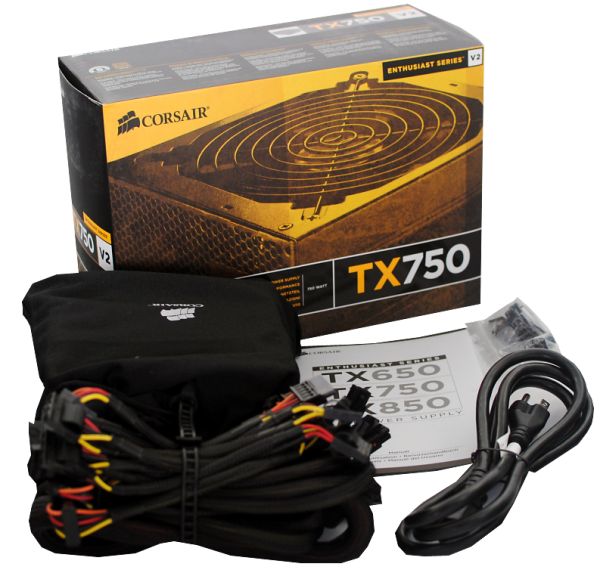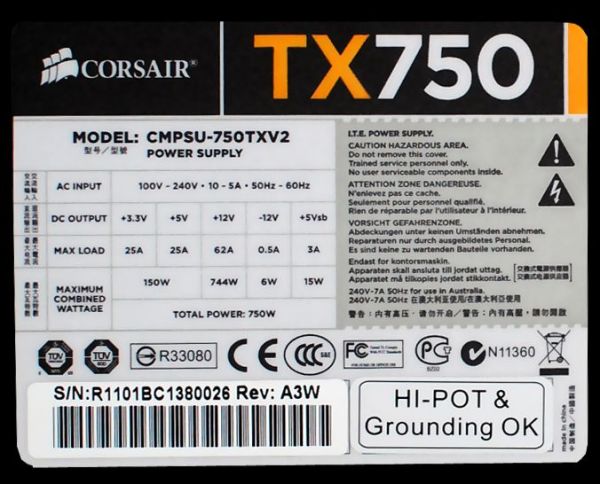Corsair TX750 V2: New and Improved
by Martin Kaffei on May 16, 2011 6:55 PM EST- Posted in
- Cases/Cooling/PSUs
- Corsair
- PSUs
- 80Plus Bronze
- 750W
- TX V2
Introduction, Package Contents, and Specifications
Today we continue with the second part of our series of 750W power supplies. The Corsair TX V2 is the second 80 Plus Bronze certified PSU with non-modular cables that we're looking at for this range. Corsair might be a leading manufacturer of RAM modules and SSDs, but power supply quality depends largely on the ODM and their design. The big question of the PSU source is easy to answer. Seasonic is the company behind many Corsair products—and they're definitely a good choice, much better than using CWT like the original TX750—but what about the internal design and components?
Corsair's TX V2 750W includes a power cord for the American power grid, four screws, one Corsair sticker (for your case), and a manual. The latter is more like a warranty agreement than a helping hand. There is an installation guide, but the warranty part shows some interesting limitations. "[Corsair] shall not be liable for any special, incidental, indirect or consequential damages [...] including [...] loss of profits, revenue, or data." So the 5-year warranty won't help you, other than getting a new PSU should the TX750 go belly up. Don't worry, though; these are common terms and are present with nearly every PSU.
While if it is not stated directly anywhere, the sticker indicates Corsair is using a single rail for +12V. We'll see later that this is not the case, so we'd like to see Corsair list both 12V rails on their sticker to avoid confusion. 744W combined power also indicates this is another PSU with DC-to-DC VRM. +3.3V and +5V are rated at 25A each and should be able to provide enough power for HDDs/SSDs and/or other peripheral components. 3A on +5VSB is also relatively strong.
Corsair uses a 140mm fan from Yate Loon with a ball bearing. The product number is D14BH-12 and it takes 0.70A. A Sanyo Denki fan would be better but the price could be a problem and Sanyo Denki is still a reason to buy the more expensive Corsair AX. Corsair differentiates between the two lines by modifications such as this, which helps them reach lower cost markets.













32 Comments
View All Comments
tomoyo - Monday, May 16, 2011 - link
It's definitely a pretty big improvement, this has been discussed on some other review sites such as jonnyguru. The TX750 v2 is a good seasonic design, the old TX750 is an older cwt design that was not a great performer. This is an awesome budget psu.JarredWalton - Monday, May 16, 2011 - link
I linked in our old TX750 review for comparison; this is a much improved product.Patrick Wolf - Monday, May 16, 2011 - link
So is this review suggesting that it not being a single rail as being a bad thing? Or just that it's specs are incorrect? I mean it's better this way. If it were single rail, the amperage on the +12V would be to high and OCP wouldn't be included, splitting the rails allows for this additional protection. Corsair shouldn't lie to the customer, but I understand why they would as most people still think single rail is superior. At least they're not claming it's multi-rail when the rails are actually combined.Martin Kaffei - Tuesday, May 17, 2011 - link
Just the specs, basically there are no disadvantage for customers. Otherwise the conclusion would have been worse for Corsair. It's still a good PSU.Guspaz - Tuesday, May 17, 2011 - link
No disadvantage, except that consumers now need to worry about balancing rails. Single-rail designs provide the huge benefit of obviating consumers of the need to worry about if they've put too much stuff on one rail instead of the other.Martin Kaffei - Tuesday, May 17, 2011 - link
Nobody needs to worry about the loads. There are just as many connectors as a rail is able to provide. Even if Corsair wants to change something with the configuration the engineers take a look at it first before they sell a single product.erple2 - Tuesday, May 17, 2011 - link
I think there's plenty of research that suggests that a high quality multi-rail PSU is just as good as a high quality single-rail PSU.There are a few exceptions where a single-rail PSU is "better", but that generally refers to instances where you are running a LOT of devices that feed off the 12V rail (10's of harddrives, fancy cooling, 3x+SLI or 3x+ CrossFire, etc).
The other part, however, (truth in advertising) is very important. If' it's a single rail PSU, advertise as such. If it's really a multi-rail PSU, advertise it as such.
Erbadios - Monday, May 16, 2011 - link
That is odd...My manual states that the version 2 of TX 650, 750 and 850 comes with a 140mm fan.
My TX650 v2 does seem to have a very large fan, but i didn't open it to acually check...
So far i like it a lot, it's somewhat quiet. I wonder if the 750TX differs a lot from the 650TX, though..
MeanBruce - Monday, May 16, 2011 - link
The smartest choice you can make is to just wait until this summer when the Corsair Professional Series Platinum debuts. Sure they cost more but well worth it over the 7year warranty period in energy savings alone!;)JarredWalton - Monday, May 16, 2011 - link
Just to do the math:Bronze vs. Platinum: 85% vs. 91% (give or take)
Assume an average daily load of 150W (idle most of the time), and we'll even let the system run 24/7. That works out to:
Bronze: 1547 KWh per year
Platinum: 1429 KWh per year
Assuming $0.10 per KWh, you would save $11.80 per year.
If you actually leave your PC on 24/7 and draw 150W or more, I suppose it could be worthwhile to upgrade to Platinum. Realistically, though, I think Bronze/Silver is more than sufficient. Just my opinion, though.